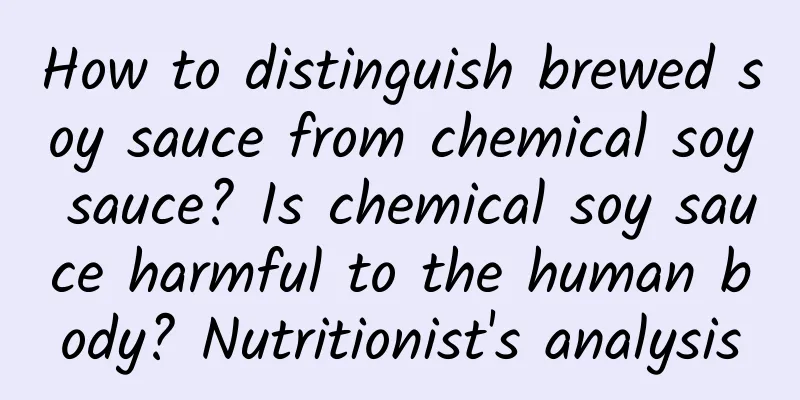How to distinguish brewed soy sauce from chemical soy sauce? Is chemical soy sauce harmful to the human body? Nutritionist's analysis

|
Soy sauce is a necessity in people's lives and is indispensable in daily cooking, including dipping sauces, marinades, seasonings, etc. Soy sauce plays a key role in adding color and flavor to dishes. Soy sauce holds the key to deliciousness. Are you buying the right one? The price of soy sauce ranges from tens of yuan to hundreds of yuan. Why is this? Is it true that chemical soy sauce is bad for your health? What is the difference between pure brewed soy sauce and chemical soy sauce? Let’s listen to the following analysis by nutritionist Lin Shihang. Analysis 1: How to distinguish brewed soy sauce from chemical soy sauce?Nutritionist Lin Shih-hang said that the term "chemical soy sauce" is not included in the regulations. In 2018, the Food and Drug Administration announced the "Regulations on the Labeling of Packaged Soy Sauce Production Process", which clearly regulates the four categories of "brewed", "hydrolyzed", "quick-made", and "blended". The words "hydrolyzed", "quick-made", and "blended" must be clearly marked on the packaging (1) so that consumers can clearly identify different types of soy sauce. Brewing is a voluntary label. If it is to be labeled "brewed", it must meet the relevant requirements. Analysis 2: Brewing soy sauce processing methods and definitionsProcessing methods of brewing soy sauce Brewing soy sauce is made from soybeans or black beans through the process of koji making and mashing, which can be divided into the following two stages: Yeast making stage Steam the soybeans or black beans, cool them down, mix them with koji and place them in a place with suitable temperature and humidity to let the koji grow. This step is called "koji making". The purpose is to use the koji enzymes to: •Hydrolyze the protein in soybeans or black beans to increase the flavor. •If wheat is added, koji amylase breaks down starch into monosaccharides to increase sweetness and also serve as a fermentation substrate. Mashing and fermentation stage After making koji, soybeans, black beans, and wheat are placed in a jar for fermentation. At this time, lactic acid bacteria and yeast use amino acids, glucose and other substances to continue the fermentation reaction, producing more diverse flavor substances. The fermentation methods can be roughly divided into: •Dry fermentation: After the koji is made, it is placed in a jar and fermentation begins after adding a large amount of salt. Because there is less water, the fermentation time is long, the amount is small but the taste is strong. It is mainly the original juice at the bottom of the jar, which is the source of the high-priced pot bottom oil. •Semi-wet fermentation: After the koji is made, it is placed in a vat. In addition to salt, some water will be added to accelerate the fermentation, and the yield is higher than the dry method. •Wet fermentation: After the koji is made, it is placed in a vat and mixed with salt water for fermentation. The top is covered with coarse salt depending on demand. This is the method used for most soy sauce production. Some follow the Japanese soy and wheat fermentation method and add wheat to add sweetness. Summary 2⟫ Definition of brewed soy sauce If the soy sauce is labeled as "brewed", it should be made by the "koji making and fermentation" method, and its total nitrogen content must be above 0.8 grams per 100 milliliters (the total nitrogen content of black bean soy sauce must be above 0.5 grams per 100 milliliters). If the total nitrogen content does not meet the requirements and the word "brewed" is labeled, it is considered a false label. Summary 3⟫ Advantages and disadvantages of brewing soy sauce Advantages of brewing soy sauce Brewed soy sauce has a rich flavor and diverse flavors, and the taste of brewed soy sauce varies depending on the koji making and fermentation methods and recipes of each family. Disadvantages of brewing soy sauce The fermentation period is long, reaching more than 120 days, and the traditional brewing method is labor-intensive, so the price of brewed soy sauce is usually higher, especially soy sauce that is handmade or uses "non-defatted soybean powder" as raw material, which is more expensive. Brewed soy sauce has a rich flavor and diverse flavors, and the taste of brewed soy sauce varies depending on the koji making and fermentation methods and recipes of each family. Analysis of the processing method and definition of hydrolyzed soy sauceProcessing methods of hydrolyzed soy sauce Hydrolyzed soy sauce is made by adding hydrochloric acid or enzymes to defatted soybean powder to hydrolyze the protein. Generally, hydrochloric acid is used, followed by acid-base neutralization, filtering and mixing. The processing does not include "fermentation". Definition of Hydrolyzed Soy Sauce A soy sauce made by hydrolyzing vegetable protein materials with acid or enzymes without fermentation. Summarize the advantages and disadvantages of hydrolyzed soy sauce Advantages of hydrolyzed soy sauce Hydrolyzed soy sauce does not go through the process of koji making and mash making, so it can be produced quickly, taking only a few days, and is inexpensive. Disadvantages of hydrolyzed soy sauce Although the protein is hydrolyzed with hydrochloric acid to produce umami amino acids, the flavor is poor because it has not been acted upon by koji, nor fermented by yeast or lactic acid bacteria. Artificial sweeteners must be added later to enhance the taste and flavor. In addition, the reaction between oil and hydrochloric acid will produce 3-monochloropropylene glycol (Note 1), which is a Class 2B carcinogen. Although the soybean powder used is defatted soybeans, some oil will still remain. Therefore, hydrolysis with hydrochloric acid will produce trace amounts of 3-monochloropropylene glycol, and the content needs to be controlled (Note 2). Note 1: Class 2B carcinogens are suspected to be carcinogenic to experimental animals, but there is insufficient evidence to prove their carcinogenicity to humans. Note 2: The current maximum daily tolerable amount of 3-MCPD is 2 micrograms per kilogram. To be harmful, one would need to consume more than 300 grams of soy sauce every day for a long time. Under normal seasoning use, it will not cause any problem (2). Analysis of the four-step soy sauce processing method and definitionSummary of the quick soy sauce processing method Nutritionist Lin Shihang said that instant soy sauce is an advanced version of hydrolyzed soy sauce. It is hydrolyzed by hydrochloric acid or enzymes, and then the amino acid hydrolysates of soybeans are fermented. Summary 2⟫ Quick Soy Sauce Definition Soy sauce is made by hydrolyzing vegetable protein materials with acid or enzymes and fermenting them. Summary of the advantages and disadvantages of quick-made soy sauce Advantages of instant soy sauce •Compared to brewed soy sauce, instant soy sauce uses hydrolysis to replace the traditional koji making method, shortening the process time. It can be made in about 1 to 2 months and is cheaper than brewed soy sauce. •Compared to hydrolyzed soy sauce, instant soy sauce has an additional fermentation step, and its flavor is better than hydrolyzed soy sauce. Disadvantages of instant soy sauce If hydrochloric acid is still used for hydrolysis, there will still be a problem of 3-monochloropropylene glycol residues, so the content needs to be controlled, just like hydrolyzed soy sauce. Analysis of the processing methods and definitions of five-component soy sauceSorting out 1. Processing methods of blended soy sauce It is a mixture of two kinds of soy sauce, which can be a mixture of brewed soy sauce, hydrolyzed soy sauce or instant soy sauce. Summary 2⟫ Definition of blended soy sauce For soy sauces made by mixing, the word "mixing" or "blending" should be clearly indicated on the packaging. Sorting out the advantages and disadvantages of three-component soy sauce Advantages of blended soy sauce Different types of soy sauce can be mixed according to brand requirements, and the flavor of hydrolyzed and instant soy sauce can be enhanced through blending. Chemical soy sauce has the advantages of being cheap and quickly processed, which can meet the cost requirements of roadside stalls and night markets, allowing the catering industry to provide cheap meals. However, because soybeans hydrolyzed with hydrochloric acid pose a risk of monochloropropylene glycol, it is necessary to establish residue standards for control. As long as the residue standards are met, there will be no food safety issues. Analysis 6: Is chemical soy sauce harmful to the human body?Nutritionist Lin Shihang said that Taiwanese consumers have many misunderstandings about chemical soy sauce. Next, the nutritionist will analyze whether "chemical soy sauce" is harmful to the human body? Summary 1. Is hydrolyzed soy sauce harmful? The hydrochloric acid hydrolysis processing method has a long history. The Amiro method used in rice wine processing also uses hydrochloric acid to hydrolyze white rice and then ferment it. The use of hydrochloric acid does not harm the body. Hydrochloric acid can avoid the strong acid problem by subsequent acid-base neutralization. However, when hydrolyzing fat-containing substances with hydrochloric acid, 3-monochloropropylene glycol, a 2B carcinogen, will be produced. This is also the reason why everyone says that chemical soy sauce is harmful to health. Summary 2⟫ Chemical soy sauce contains carcinogens, is it harmful to the human body? Using hydrochloric acid to hydrolyze soybeans will produce 3-monochloropropylene glycol, which is listed as a carcinogen, but is a Class 2B carcinogen whose harm to the human body is still unclear. Toxicological studies have also pointed out that if you consume more than 300 grams of soy sauce every day, the 3-monochloropropanediol in it will reach the maximum daily allowable amount, so there is no need to panic. Conclusion Chemical soy sauce has the advantages of being cheap and quickly processed, which can meet the cost requirements of roadside stalls and night markets, allowing the catering industry to provide cheap meals. However, because soybeans hydrolyzed with hydrochloric acid pose a risk of monochloropropylene glycol, it is necessary to establish residue standards for control. As long as the residue standards are met, there will be no food safety issues. If consumers do not want to buy chemical soy sauce, they should pay attention to the labels when choosing soy sauce. By choosing soy sauce labeled "brewed", they can avoid buying chemical soy sauce. Source: Regulations on labeling the production process of packaged soy sauce. Food and Drug Administration, Ministry of Health and Welfare. 2018. Monochloropropylene glycol Q&A. Food and Drug Administration, Ministry of Health and Welfare. 2013 |
Recommend
What are the causes of uterine prolapse?
What are the causes of uterine prolapse? Uterine ...
How to effectively prevent dysmenorrhea
Dysmenorrhea is a common disease among women. The...
The golden day for weight loss and fat removal is the most effective! Nutritionist Zhao Hanying: 4 tips to break through the weight loss burnout period
Many people will experience a period of fatigue d...
Can't control your mouth? 5 ways to stop cravings
The Chinese New Year has just passed, and during ...
What are the treatments for uterine fibroids?
The treatment of uterine fibroids should be based...
Can early cervical warts be cured?
Can early cervical warts be cured? Experts say ye...
What medicines can treat Bartholinitis?
What drugs can treat Bartholinitis? In the early ...
There is a blacklist for souvenirs! Fruit is my favorite
The New Year is approaching, and everyone loves t...
How to judge whether brown discharge after abortion is normal? Do you know the two treatments for brown discharge after abortion?
Whether brown discharge from the vagina after an ...
What is rectal pelvic effusion?
If a disease like pelvic effusion occurs, it may ...
TCM Syndrome Differentiation Analysis of Common Symptoms of Uterine Fibroids
Uterine fibroids are benign tumors located in the...
Treatment of pelvic effusion in pelvic inflammatory disease
Treatment of pelvic effusion in pelvic inflammato...
Is it possible to have an oophorectomy for ovarian cysts?
Can ovarian cysts be removed? 1. There are many p...
Misuse of antibiotics can cause vaginitis
"Whenever I catch a cold or my immune system...
Will chocolate cysts grow larger during menopause?
During menopause, chocolate cysts may increase in...









